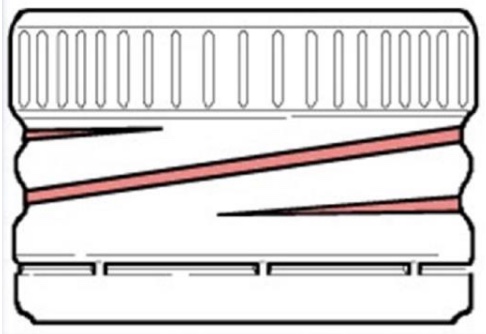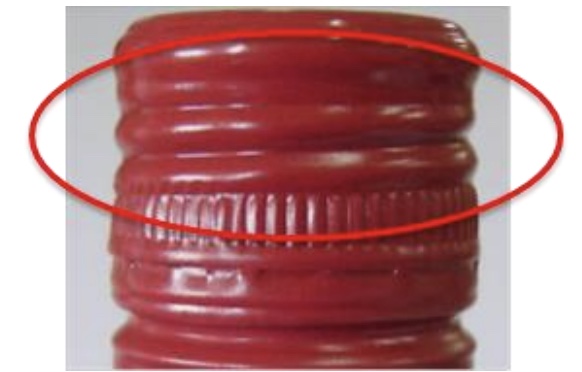Par Nicholas Harris
Le 05/03/2018
Le 05/03/2018
Prevention of defects in aluminium screw caps
Cetie Bottling Guides
The Cetie Bottling Guides are intended above all to help bottlers avoid defects when using the closure systems in question. In reality, however, the "zero defects" concept only exists as a goal, even when the best practices are put in place. This goal must be complemented by the ability to rapidly recognise the defects that can occur, take the appropriate corrective actions and identify the preventive measures to remedy the problem over the long run. Cetie has therefore recently supplemented its publications with a new Bottling Guide No. 11, as previously announced in these articles, which specifically addresses the identification and correction of defects in capping with ROPP (Roll-On Pilfer-Proof) closures.
Bottling guide N°11
This document was developed during the sessions held by Cetie’s groups of experts, convened to revise Bottling Guide No. 6 Metallic Screw Capping for Still Wines on BVS-Type Glass Finish (published in 2016) and Bottling Guide No. 2 Metallic Screw Capping for Non-Carbonated Liquids, Foodstuffs and Pharmaceutical Products (revision in progress) and to produce Guide No. 9 Metallic Screw Capping of Pressurized Wines & Other Beverages on BVS-Type Glass Finishes (published in 2016). Initially, the intention was for the first of the above documents to include one chapter devoted to the identification and correction of capping defects. It rapidly became obvious, however, that given the quantity of information available and its applicability to all the ROPP closure applications, it would be worthwhile developing this chapter to produce a reference document in its own right.
Illustrated capping defects
Guide No. 11 now comprises 41 pages, contains 44 illustrations and lists 26 types of capping defects with their possible causes and the appropriate corrective actions. At present published in English, the main working language of the groups involved, under the title Aluminium Screw Capping Defects – Identification and Correction, the French version will be published shortly, along with the revised Guide No. 6 and the new Guide No. 9. In the meantime, before discovering it in greater detail, here is some information on the content of this Guide.
Ishikawa quality control chart
The first chapter illustrates some of the defects that can occur on the glass bottle finish or the cap before fitting, and which can affect the functions of the cap once fitted (sealing, removal torque) or the capping operation. Fifteen of the most visual types of capping defects are covered by "defect sheets" with a photo and/or a diagram of each defect, a list of possible causes and the corresponding verifications/corrective actions. It should be noted that the photographs were selected to clearly show the defects described, defects that were induced artificially where necessary.
The functional defects relating to removal torque (too high, too low) are described in sheets without images.
These sheets are followed by a defect correction guide presented as a list divided into five tables according to the defect location or the function concerned. This list takes up and supplements the defects set out in the preceding section, indicating the possible causes and corresponding corrective actions for each one. Lastly, the document provides examples of the application of the "6 M"/Ishikawa quality control technique used in the prevention of capping defects. (Ex. Below)
Thirty contributors
Some thirty experts from about twenty Cetie member companies concerned - manufacturers of caps, liners and their constituent materials, glass bottles, capping and bottling machines - have contributed to this publication. As is often the case in collective projects, one of the experts was a particularly crucial contributor, providing a document that ensured a sound basis on which the group could work to draw up this Guide, and continuing to play an extremely active role during its development. The person in question is Jacques Granger, a packaging consultant with many years of loyal service as an expert at Cetie, where he represented Amcor Flexibles Packaging until the end of 2015 and was subsequently appointed Honorary Member of Cetie by the Board of Directors. Mr Granger was moreover interviewed on this subject (L&C 374 11/2014) as chairman of the Cetie Working Group on the capping with ROPP closure Guides at that time.
As with all Cetie publications, Guide No. 11 can be downloaded free of charge from our website www.cetie.org if you have a user account. If you are not yet a registered user, send us your account application on the contact form accessible via the link in the "Contact" tab on the website homepage.
Enjoy reading.
 |
 |
| Figure 19 — Poorly formed threads | Figure 20 — Example of poorly formed threads |
Fig 1. Images showing an example of a capping defect – Broken bridges on short-skirt closure
Nicholas Harris - for french Magazine Liquides & Conditionnement N°388
- Liquides & Conditionnement N°388 (FR) Tags : , , , ,
Commentaires
Aucun commentaire
Ajouter commentaire
Vous devez être connecté pour pouvoir saisir un commentaire.
Recherche



